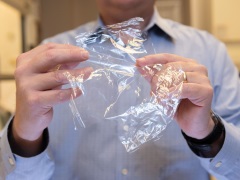Features
When chitin met cellulose
Date: 2018-07-30 14:33:38.0
Author: Jon Evans

Carson Meredith from Georgia Institute of
Technology holds new packaging material
made from cellulose and chitin.
Photo: Allison Carter, Georgia Tech.
Cellulose is the most abundant biopolymer on Earth and has already demonstrated its potential as the building block for a whole range of different materials, including textiles, packaging, foam and filters (see Cellulose adapts to new roles). But cellulose is not the only natural choice for such applications, because chitin, the second most abundant biopolymer on Earth, also shows great promise.
Whereas cellulose is a polymer of glucose, chitin, whose abundance comes from it being the main component in fungal cell walls and the exoskeletons of invertebrates such as crustaceans and insects, is a polymer of acetyl glucosamine, and so the two have different physical properties. This is now inspiring scientists to explore what kinds of materials they can produce by combining these two highly abundant biopolymers together.
The first challenge, though, is to find effective ways to combine them, and also to process them. Because not only are cellulose and chitin insoluble in water and many common organic solvents, but their different physical properties mean that scientists have struggled to find a single solvent that can effectively dissolve both of them.
In a recent paper in Carbohydrate Polymers, however, a team of German chemists report developing such a solvent by mixing an ionic liquid with gamma-valerolactone, which can be obtained from plant biomass. By dissolving cellulose and chitin in this solvent and then allowing the mixture to dry, they were able to produce composite materials that varied in both their elasticity and the hydrophobicity depending on the concentration of chitin.
Other chitin-derived materials require more extensive processing and this can adversely affect the mechanical properties of chitin, in which case cellulose can provide additional strength. This was the case when a team of chemists from China and the UK were looking to develop a biocompatible and biodegradable suture material from chitin. They developed a method for producing so-called regenerated chitin fibers by dissolving chitin in a solution of sodium hydroxide and urea and then conducting a freeze-thaw process to precipite them out.
Although the resultant regenerated fibers could be spun into a suture, they weren’t strong enough for practical applications. But as the chemists report in another paper in Carbohydrate Polymers, adding bacterial cellulose, which tends to have fewer impurities than plant cellulose, to the chitin improved the mechanical performance of the fibers. Sutures made from these fibers were able to promote wound healing when tested in mice.
Chitin can be made more soluble, and thus easier to process, by converting it to chitosan, which is done by heating it in a concentrated alkaline solution to remove many of its acetyl groups. But chitosan has poorer mechanical properties than chitin, and so scientists have also tried combining it with cellulose. For example, a team of scientists in Singapore recently showed that dissolving cellulose with small amounts of chitosan (less than 30%) in acetic acid produces a material that can be used for 3D printing (see Natural approach to 3D printing).
In contrast, a team of US scientists took advantage of the fact that in certain solvents chitosan becomes positively charged and cellulose becomes negatively charged, allowing them to be deposited as alternating layers that naturally bind to each other. In a paper last year in Green Chemistry, the team reported that these layers can form barrier coatings able to resist water, oil and a salt solution.
Now, in a recent paper in ACS Sustainable Chemistry & Engineering, Carson Meredith and his team at the Georgia Institute of Technology, US, report doing the same thing with chitin and cellulose. In this case, they deposited the layers using spray coating, which meant they just needed to suspend the cellulose and chitin in a solvent rather than dissolve them. They found that spraying several alternating layers of chitin and cellulose onto polylactic acid produced a film that was better at blocking the passage of oxygen than polyethylene terephthalate, showing its potential for keeping food fresh.
The one potential stumbling block to developing all these materials is that, despite its theoretical abundance, chitin is not yet being produced at industrial scales. But seeing as it can easily be obtained from the currently discarded shells produced by the seafood industry that shouldn’t be a problem.
The views represented here are solely those of the author and do not necessarily represent those of John Wiley and Sons, Ltd. or of the SCI.
Displaying 2 keywords used to tag this article:
- DG6582 Mens Moncler Down Jackets Gr
- Jules Audemars-Australia Best Quali
